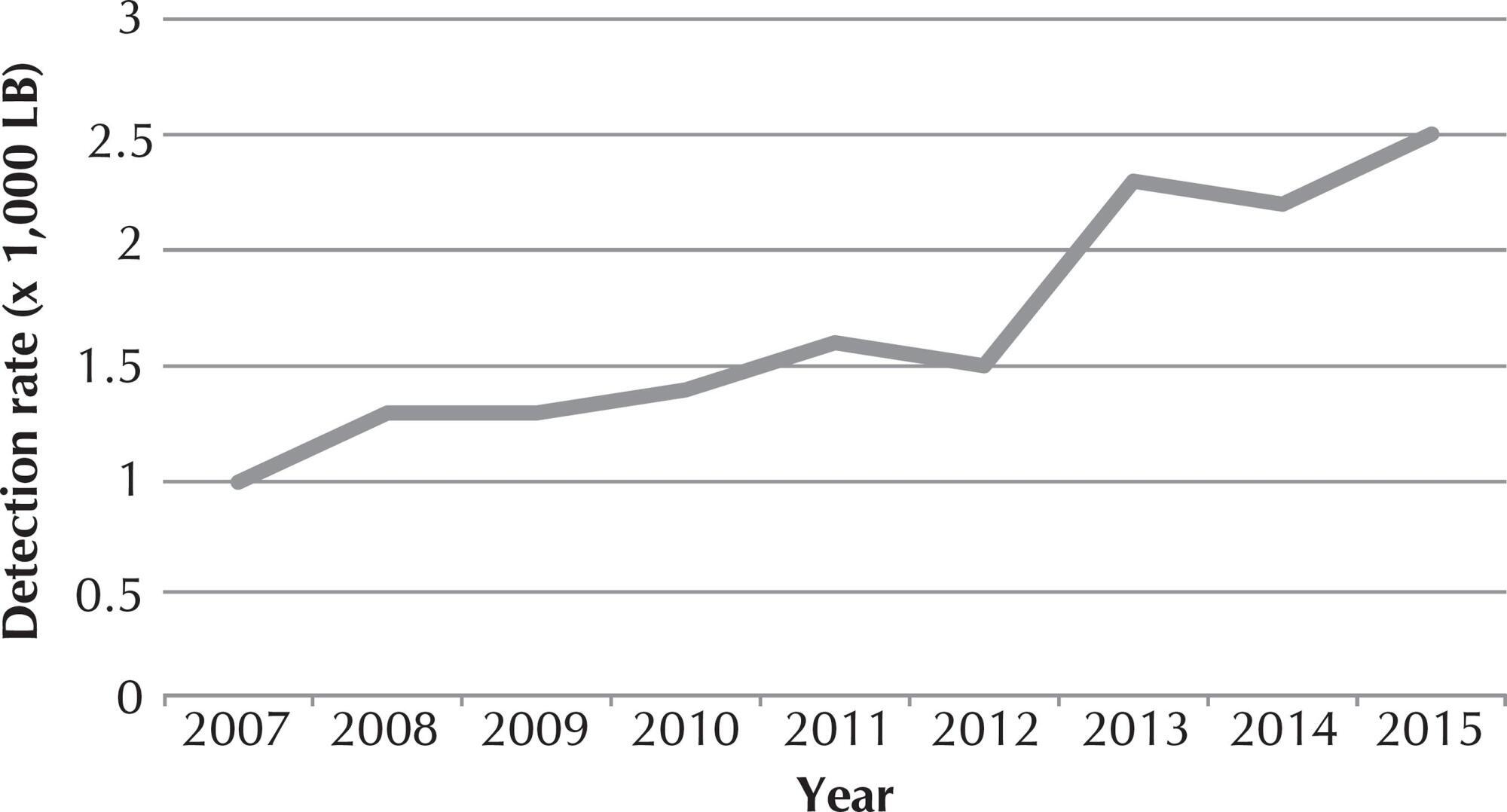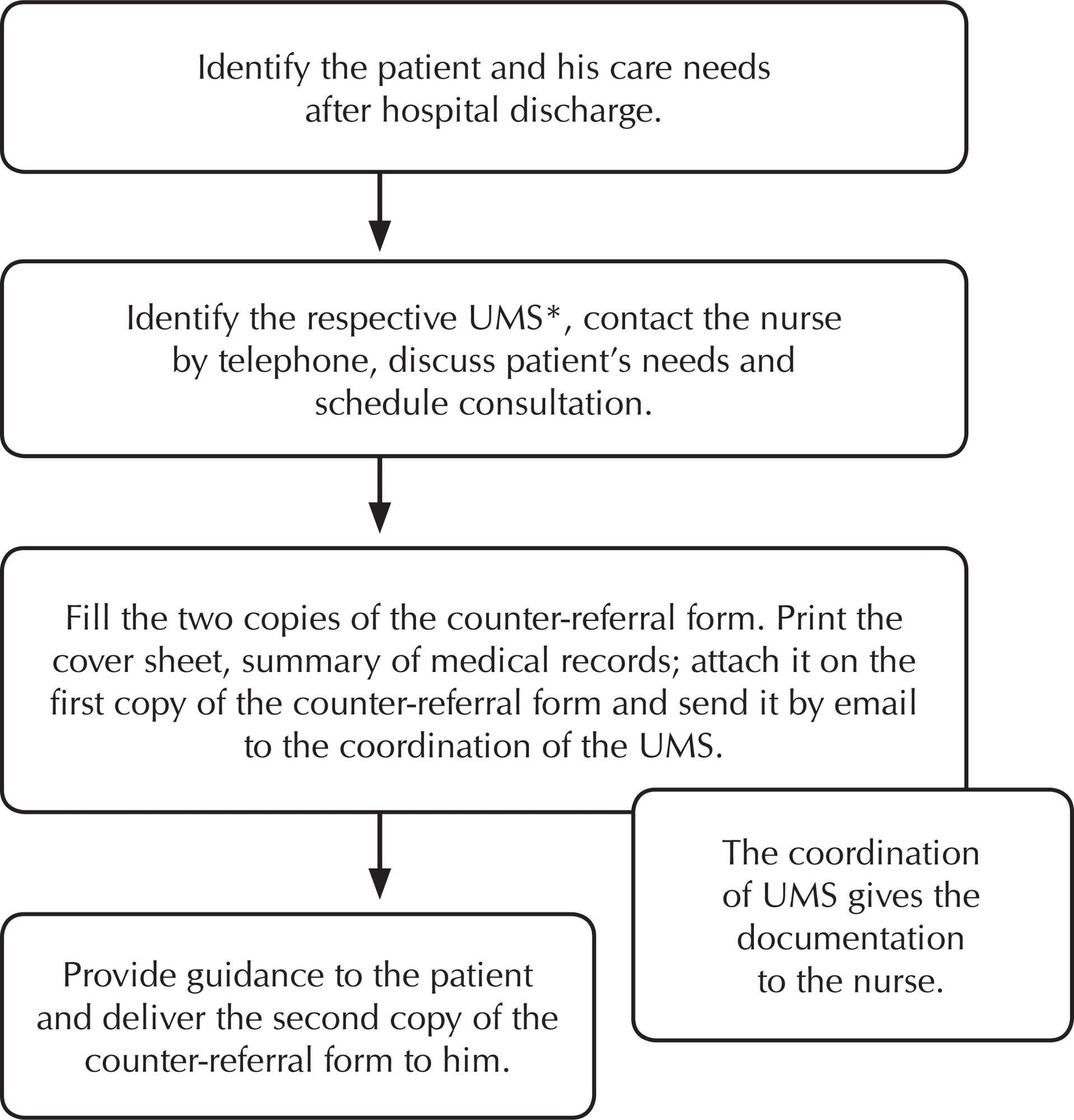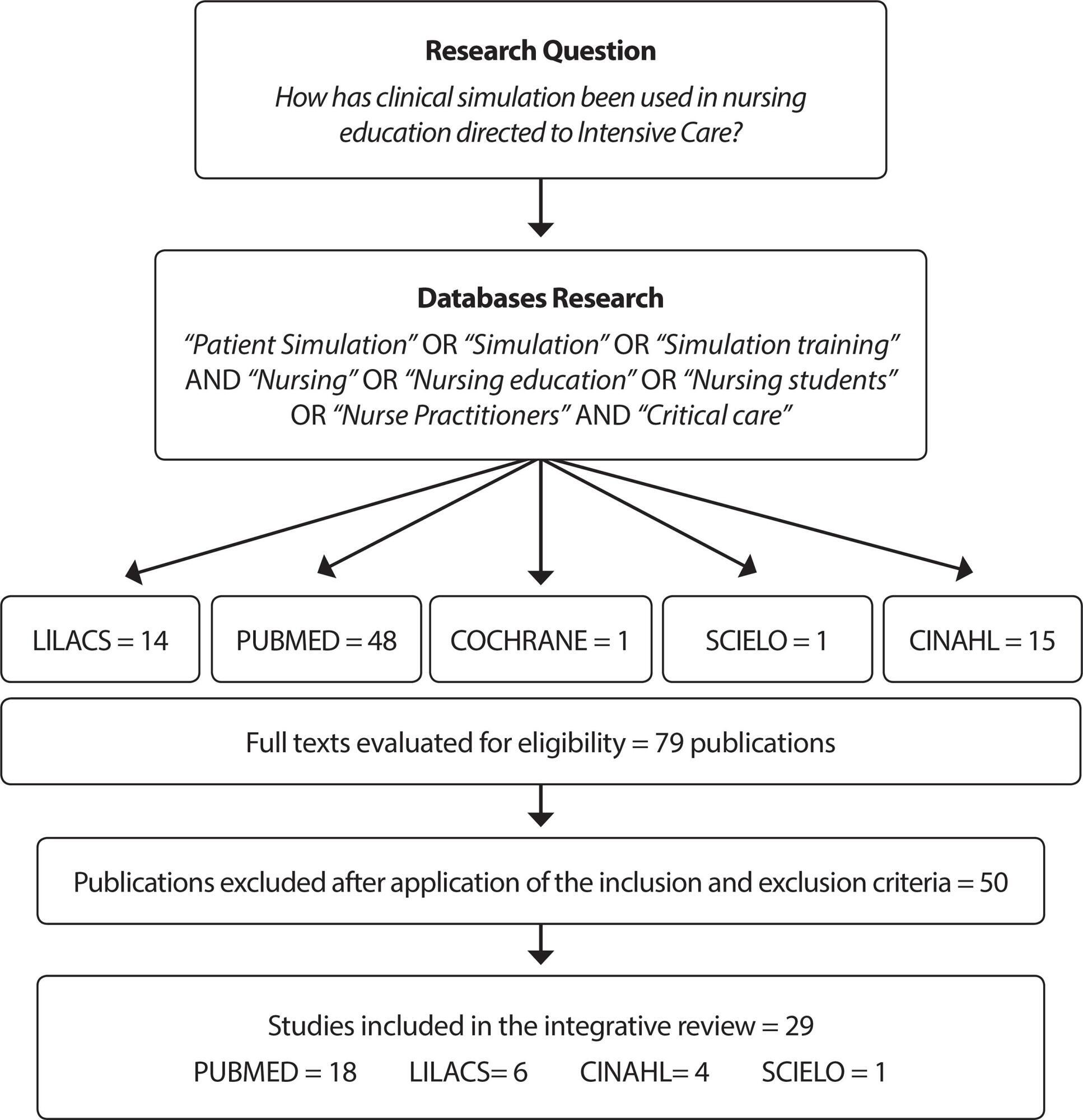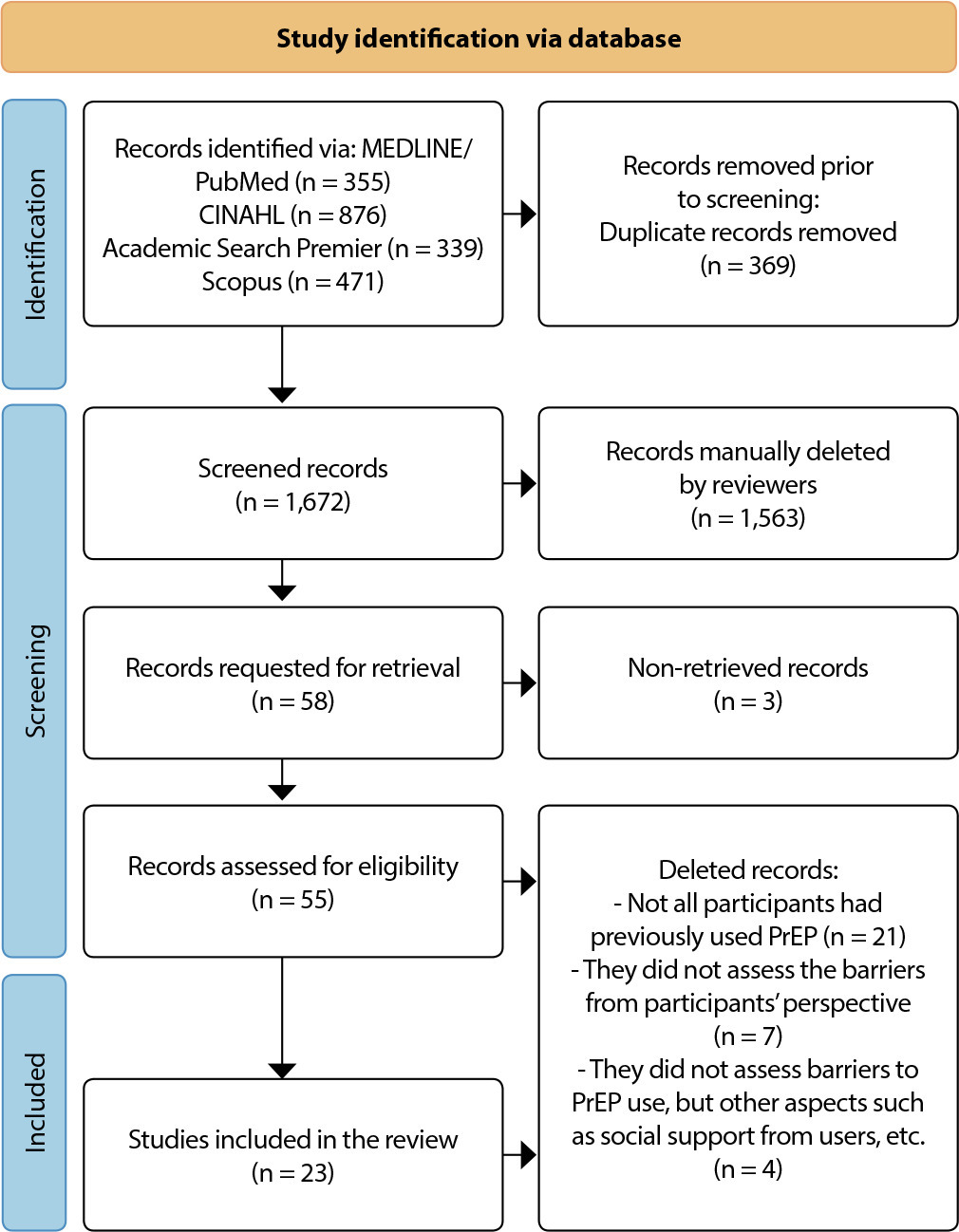-
01/01/2018
Declínio da mortalidade por câncer cervical
Revista Brasileira de Enfermagem. 2018;71:585-590
Resumen
Declínio da mortalidade por câncer cervical
Revista Brasileira de Enfermagem. 2018;71:585-590
DOI 10.1590/0034-7167-2016-0530
Visualizações0Ver maisRESUMEN
Objetivo:
Describir la ocurrencia de mortalidad por cáncer cervical en Recife (PE), en el noreste de Brasil.
Método:
Este fue un estudio ecológico de series temporales que utilizó datos del Sistema de Información de Mortalidad (SIM) sobre el número total de muertes por cáncer cervical (C53 ICD10) ocurridas entre 2000 y 2012.
Resultados:
Se observó que el riesgo de muerte por esta forma de cáncer fue mayor entre las mujeres mayores de 60 años, las de color de piel mixto (53.24%), las que sólo trabajaban en casa (63.16%) y las que no tenían pareja (44.32%).
Conclusión:
Se requieren esfuerzos adicionales para mantener los programas de detección precoz y educación sanitaria y para utilizar estrategias terapéuticas de mayor eficacia, ya que la mortalidad por esta forma de cáncer se considera evitable cuando se diagnostica tempranamente.
-
PESQUISA01/01/2018
Adhesion to patient safety protocols in emergency care units
Revista Brasileira de Enfermagem. 2018;71:577-584
Resumen
PESQUISAAdhesion to patient safety protocols in emergency care units
Revista Brasileira de Enfermagem. 2018;71:577-584
DOI 10.1590/0034-7167-2017-0504
Visualizações0Ver maisABSTRACT
Objective:
To investigate compliance of national patient safety protocols in Emergency Care Units (UPA) of the Paraná State.
Method:
From April until September 2016, the exploratory stage of the action research was conducted on stratified sampling with 377 patients of eight units, with use of verification instrument of basic safety actions.
Results:
The absence of systematic identification of patients, fall risk assessment and signaling and development of pressure injuries were evidenced. We observed that 52.8% of parenteral solutions in use were not identified and that, in only 29.4% of the cases, the allergic condition was investigated. In 80.6% of the emergency units there was availability of alcoholic solution to hand hygiene.
Conclusion:
We concluded that the non-compliance of basic actions concerning patient safety exposes users to preventable adverse events and demands systematized actions to comply with government guidelines and promote quality of health assistance.
-
PESQUISA01/01/2018
Epidemiological overview of HIV/AIDS in pregnant women from a state of northeastern Brazil
Revista Brasileira de Enfermagem. 2018;71:568-576
Resumen
PESQUISAEpidemiological overview of HIV/AIDS in pregnant women from a state of northeastern Brazil
Revista Brasileira de Enfermagem. 2018;71:568-576
DOI 10.1590/0034-7167-2017-0495
Visualizações0Ver maisABSTRACT
Objective:
To learn the epidemiological characteristics of HIV infection in pregnant women.
Method:
Descriptive study with quantitative approach. The study population was composed of pregnant women with HIV/AIDS residing in the state of Alagoas. Data were organized into variables and analyzed according to the measures of dispersion parameter relevant to the arithmetic mean and standard deviation (X ± S).
Results:
Between 2007 and 2015, 773 cases of HIV/AIDS were recorded in pregnant women in Alagoas. The studied variables identified that most of these pregnant women were young, had low levels of education and faced socioeconomic vulnerability.
Conclusion:
It is necessary to include actions aimed at increasing the attention paid to women, once the assurance of full care and early diagnosis of HIV are important strategies to promote adequate treatment adherence and reduce the vertical transmission.

-
PESQUISA01/01/2018
Hand hygiene management among nurses: collective health challenges
Revista Brasileira de Enfermagem. 2018;71:562-567
Resumen
PESQUISAHand hygiene management among nurses: collective health challenges
Revista Brasileira de Enfermagem. 2018;71:562-567
DOI 10.1590/0034-7167-2017-0538
Visualizações0Ver maisABSTRACT
Objective:
To describe the determining factors in hand hygiene management among nurses and identify associated collective health challenges.
Method:
Cross-sectional descriptive study. Data were collected using a questionnaire that was applied in four internal medicine units of a hospital of reference in Portugal.
Results:
The sample was composed of 50 nurses aged 26 to 55 years (mean age of 34.88 years); 80% were women, 58% had a Bachelor’s degree, and had 5-30 years of nursing practice (X̄ =11.94;±5.92). The vast majority of nurses (90%) reported complying with the existing recommendations on hand hygiene in pre-established moments. However, none of the nurses were able to identify all the moments for hand hygiene using water and soap or alcohol-based handrub.
Conclusion:
This study shows that continuous training, adequate materials/structures in the units, and redesigned administration/supervision practices are determining factors to achieve higher levels of adherence to hand hygiene among nurses, as well as increased quality and safety in care delivery, which is a current collective health challenge.
-
PESQUISA01/01/2018
How do old men take care of their own health in Primary Care?
Revista Brasileira de Enfermagem. 2018;71:554-561
Resumen
PESQUISAHow do old men take care of their own health in Primary Care?
Revista Brasileira de Enfermagem. 2018;71:554-561
DOI 10.1590/0034-7167-2017-0131
Visualizações0Ver maisABSTRACT
Objective:
To understand the care of elderly men with their own health.
Method:
A qualitative study with the participation of ten elderly men, through responses to the semi-structured interview guided by the “Tell me about your experiences of care with your health”, carried out in a basic health unit, during the period of October-December 2014. The speeches, after being transcribed were submitted to content analysis.
Results:
The ten interviewees were retired and had an average age of 67.3 years. From the analysis of the data, two categories have emerged: Elderly health care ways and health service as a supporter in the care (less) of the elderly, which revealed the restriction of health care to the triad: medicines, consultation to professionals and exams.
Final considerations:
Institutional and sociocultural barriers that need to be overcome so that the male population can be consolidated, guaranteeing care of their peculiarities, encouraging active behaviors for self-care.
-
PESQUISA01/01/2018
Nurse liaison: a strategy for counter-referral
Revista Brasileira de Enfermagem. 2018;71:546-553
Resumen
PESQUISANurse liaison: a strategy for counter-referral
Revista Brasileira de Enfermagem. 2018;71:546-553
DOI 10.1590/0034-7167-2017-0490
Visualizações0Ver maisABSTRACT
Objective:
to identify the profile of the counter-referred patients by the “nurse liaison” and to describe the experience of the professionals who participated in the project.
Method:
intervention research, with twelve nursing nurses from a hospital and an Emergency Care Unit, and 26 nurses from Primary Health Care. Data were obtained through questionnaires and counter-referral forms.
Results:
Out of 43 counter-referred individuals, 62.8% are over sixty years, 53.5% are men with multi-pathologies. Among the positive aspects, the nurses highlighted the dialogue between health care services, agility in the acquisition of inputs for the continuity of care in primary care, benefiting patients after hospital discharge. The greatest challenge was the lack of time and the deficit of nurses to perform the function.
Final considerations:
the presence of the “nurse liaison” has proved to be an important strategy to improve integration between services and to promote continuity of care.

-
PESQUISA01/01/2018
Depression in the wives of convicted men: prevalence and associated factors
Revista Brasileira de Enfermagem. 2018;71:538-545
Resumen
PESQUISADepression in the wives of convicted men: prevalence and associated factors
Revista Brasileira de Enfermagem. 2018;71:538-545
DOI 10.1590/0034-7167-2017-0263
Visualizações0Ver maisABSTRACT
Objective:
To estimate the prevalence of depression and to identify the main risk factors associated with depression in wives of convicted men.
Method:
Descriptive, cross – sectional, quantitative approach. The data were collected with 349 female partners of convicted patients in three penitentiaries in the state of Paraná, with a semistructured research, between January and June of 2016, being compiled in a database and analyzed using SPSS® 20.0 software.
Results:
It was possible to identify vulnerability to depression among wives of convicted men, most were young and 42.2% have or already had depression. It was verified that the variables to depression were ages equal to or above 30 years (50.3%, p <0.001), smoking (61.1%, p <0.013) and alcoholism (16.1%, p <0.001).
Conclusion:
It is the responsibility of the nurse with the multidisciplinary health team to invest in health promotion and prevention actions against these risk factors that were associated with depression in this population.
-
01/01/2018
Primary health care: the experience of nurses
Revista Brasileira de Enfermagem. 2018;71:531-537
Resumen
Primary health care: the experience of nurses
Revista Brasileira de Enfermagem. 2018;71:531-537
DOI 10.1590/0034-7167-2016-0244
Visualizações0ABSTRACT
Objective:
to understand the meaning of nursing care in primary health care from the perspective of Chilean nurses.
Method:
this was a qualitative study based on the social phenomenology of Alfred Schutz. Data was collected between January and April 2013, through interviews with 13 primary health care nurses in Chile.
Results:
the nurses perceived primary care as a gratifying experience, considering it an encounter of subjectivities. However, they felt burdened with multiple functions and by the hierarchical pressure to achieve targets. They strived to implement innovative care, expressed by the desire to go beyond traditional care practices, and improve the efficiency of management at the various levels of health care.
Conclusion:
it is important to discuss the results of the present study in the context of health care and especially nursing education, with the goal of better preparing nurses who will deliver care at the primary health care level.
Palavras-chave: Family Nurse PractitionersNursing CarePractical NursingPrimary Health CareQualitative ResearchVer mais
-
ARTÍCULO ORIGINAL08/06/2020
Usabilidade de um aplicativo móvel sobre o autocuidado com o pé diabético
Revista Brasileira de Enfermagem. 2020;73(4):e20180862
Resumen
ARTÍCULO ORIGINALUsabilidade de um aplicativo móvel sobre o autocuidado com o pé diabético
Revista Brasileira de Enfermagem. 2020;73(4):e20180862
DOI 10.1590/0034-7167-2018-0862
Visualizações0Ver maisRESUMO
Objetivos:
avaliar a usabilidade pelo usuário final de um protótipo de aplicativo para o autocuidado com o pé diabético.
Métodos:
estudo descritivo, de avaliação heurística da usabilidade de um aplicativo híbrido. Participaram 15 usuários de um serviço ambulatorial de atenção à pessoa com diabetes de uma capital do Nordeste brasileiro durante o mês de abril de 2018. Foi aplicado o instrumento de mensuração de usabilidade chamado Smartphone Usability questionnaiRE.
Resultados:
obteve-se como menor escore 77 e maior 112, com média de usabilidade geral de 96,1 pontos. A usabilidade foi enquadrada nos dois últimos níveis, 70 e 80. Os usuários passam a concordar fortemente (nível 70) e totalmente (nível 80) com os itens avaliados, o que representa boa usabilidade do protótipo de aplicativo.
Conclus
ões: o produto final desenvolvido tem foco nas necessidades e exigências do usuário, o que pode garantir a usabilidade, com base na tríade eficácia, eficiência e satisfação.
-
ARTÍCULO ORIGINAL18/10/2022
Percurso metodológico para alcance do grau de saturação na pesquisa qualitativa: teoria fundamentada
Revista Brasileira de Enfermagem. 2022;75(2):e20201379
Resumen
ARTÍCULO ORIGINALPercurso metodológico para alcance do grau de saturação na pesquisa qualitativa: teoria fundamentada
Revista Brasileira de Enfermagem. 2022;75(2):e20201379
DOI 10.1590/0034-7167-2020-1379
Visualizações0Ver maisRESUMO
Objetivos:
alcançar o grau de saturação em estudo que aplicou a teoria fundamentada.
Métodos:
pesquisa qualitativa, realizada em quatro Unidades Saúde da Família, entre junho de 2018 e maio de 2019. Os dados das entrevistas com 30 profissionais de saúde e observação não participante foram codificados nas etapas: aberta, axial e integração.
Resultados:
o grau de saturação foi alcançado por dois modelos conceituais – saturação teórica e temática indutiva. Foram considerados para a saturação teórica: o desenvolvimento dos códigos conceituais e a observação, na coleta e análise dos dados, quando geravam novas categorias/subcategorias ou apenas indicavam instâncias crescentes. Para a saturação temática indutiva, destacou-se a utilização de novos códigos baseados em cada entrevista.
Considerações Finais:
a esquematização visual para a quantidade de códigos, abrangência teórica dos conceitos e delimitação dos grupos amostrais orientou a identificação do grau de saturação para o desenvolvimento do corpo conceitual que sustentou a teoria substantiva.
-
ARTÍCULO ORIGINAL05/12/2019
Elderly caregivers of the elderly: frailty, loneliness and depressive symptoms
Revista Brasileira de Enfermagem. 2019;72:88-96
Resumen
ARTÍCULO ORIGINALElderly caregivers of the elderly: frailty, loneliness and depressive symptoms
Revista Brasileira de Enfermagem. 2019;72:88-96
DOI 10.1590/0034-7167-2018-0137
Visualizações0Ver maisABSTRACT
Objective:
to investigate the association between frailty, loneliness and depressive symptoms of elderly caregivers.
Method:
a cross – sectional study carried out with 341 elderly caregivers enrolled in Family Health Units of a city in the countryside of São Paulo State. The interviews were domiciliary and included questionnaire for characterization of the caregiver, Fried’s frailty phenotype, family APGAR (family functionality), Geriatric Depression Scale (depressive symptoms) and item 3 of the Herth Hope Scale (loneliness). Logistic regression was used to analyze the association between depressive symptoms and solitude (independent variables), and frailty and pre-frailty (dependent variables).
Results:
there was an association between frailty, loneliness and depressive symptoms. Elderly caregivers had increased odds of 158% presenting pre-frailty, and 360% of frailty. Elderly caregivers with depressive symptoms had an increased chance of 242% of presenting fragility.
Conclusion:
elderly and lonely caregivers with depressive symptoms are more likely to be frail and pre-frail.
-
REFLEXIÓN03/05/2021
A teoria de Florence Nightingale e suas contribuições para o pensamento crítico holístico na enfermagem
Revista Brasileira de Enfermagem. 2021;74(2):e20200139
Resumen
REFLEXIÓNA teoria de Florence Nightingale e suas contribuições para o pensamento crítico holístico na enfermagem
Revista Brasileira de Enfermagem. 2021;74(2):e20200139
DOI 10.1590/0034-7167-2020-0139
Visualizações0RESUMO
Objetivo:
refletir sobre o legado de Florence Nightingale e descrever suas contribuições para o pensamento crítico holístico na enfermagem.
Métodos:
trata-se de uma reflexão teórica, para a qual serviram de base produções científicas sobre a teoria ambientalista de Florence Nightingale, publicadas em periódicos nacionais e internacionais.
Resultados:
a filosofia e os ensinamentos de Florence Nightingale enfatizam que a enfermeira deve usar o cérebro, o coração e as mãos na criação de ambientes de cura, para cuidar do corpo do paciente, de sua mente e de seu espírito. A enfermagem, desde a época de Nightingale, vem construindo o paradigma holístico, em todas as escolas de pensamento, com vistas a uma abordagem humanística do ser humano em sua indivisível relação com o ambiente.
Considerações finais:
as contribuições de Florence ao pensamento crítico holístico na enfermagem são evidentes, constituindo o diferencial do enfermeiro na prática clínica.
Palavras-chave: Cuidados de EnfermagemEnfermagemHistória da EnfermagemPensamento CríticoTeoria de EnfermagemVer mais -
19/08/2019
Clinical simulation in nursing education in intensive therapy: an integrative review
Revista Brasileira de Enfermagem. 2019;72(4):1061-1070
Resumen
Clinical simulation in nursing education in intensive therapy: an integrative review
Revista Brasileira de Enfermagem. 2019;72(4):1061-1070
DOI 10.1590/0034-7167-2018-0217
Visualizações0Ver maisABSTRACT
Objective:
to analyze the publications on clinical simulation practices for education in Nursing in Intensive Care.
Method:
an integrative review carried out through LILACS, PubMed, Cochrane Library, CINAHL and SciELO databases, of articles published from 2008 to 2017.
Results:
29 articles were selected, of which 76% discuss the use of simulation in continuing education of nursing professionals, while the others describe their use for student education. There is a higher prevalence of studies with a level of evidence 6 (17), with 28 international publications. There was an increase in scientific production, with 16 articles published in the last three years.
Conclusion:
variables after simulation use, such as confidence, communication skills, efficiency in the identification of clinical worsening of patients, development of technical skills, teamwork and clinical decision-making, presented a significant improvement, demonstrating that this tool is effective in qualifying care for critical patients.

-
ARTÍCULO DE REVISIÓN26/06/2023
Barriers to Pre-Exposure Prophylaxis (PrEP) use for HIV: an integrative review
Revista Brasileira de Enfermagem. 2023;76(3):e20210963
Resumen
ARTÍCULO DE REVISIÓNBarriers to Pre-Exposure Prophylaxis (PrEP) use for HIV: an integrative review
Revista Brasileira de Enfermagem. 2023;76(3):e20210963
DOI 10.1590/0034-7167-2021-0963
Visualizações0Ver maisABSTRACT
Objectives:
to identify and synthesize scientific evidence on the barriers and difficulties for Pre-exposure Prophylaxis (PrEP) use and compliance for HIV.
Methods:
an integrative literature review, using the MEDLINE/PubMed, Cumulative Index to Nursing and Allied Health Literature (CINAHL), Academic Search Premier and Scopus (Elsevier) databases.
Results:
all (100%) the articles included identified that PrEP users experience some type of structural barrier related to health services such as long distance from the units, suboptimal logistics for taking pills and professional resistance to prescribing PrEP. Furthermore, 63.21% identified social barriers, such as stigma about sexuality and HIV, in addition to individual barriers such as alcohol use, adverse effects, and concerns about long-term toxicity.
Conclusions:
the barriers to PrEP use are multifactorial. Effective interventions are needed to support PrEP users in accessing, complying with, and retaining health services.

-
ARTÍCULO ORIGINAL21/10/2019
Coping religioso/espiritual e a angústia espiritual em pessoas com câncer
Revista Brasileira de Enfermagem. 2019;72(6):1534-1540
Resumen
ARTÍCULO ORIGINALCoping religioso/espiritual e a angústia espiritual em pessoas com câncer
Revista Brasileira de Enfermagem. 2019;72(6):1534-1540
DOI 10.1590/0034-7167-2018-0585
Visualizações1Ver maisRESUMO
Objetivo:
Investigar a relação entre presença de angústia espiritual e uso do coping religioso/espiritual com variáveis sociodemográficas, clínicas e de aspectos religioso/espiritual em pessoas com câncer.
Método:
Estudo transversal, realizado em uma associação de apoio à pessoa com câncer. Os dados obtidos dos instrumentos foram analisados por meio do coeficiente de correlação de Spearman e do teste Mann-Whitney.
Resultados:
Participaram do estudo 129 voluntários; 57% apresentaram moderada angústia espiritual, e 96% faziam uso de médio e alto coping religioso/espiritual positivo. A angústia espiritual apresentou correlação positiva com o coping religioso/espiritual negativo (P < 0,001) e inversa com a idade (p 0,002). O uso do coping religioso positivo foi estatisticamente significativo em pessoas que desenvolvem práticas religiosas (p 0,001).
Conclusão:
A angústia espiritual é um fenômeno presente na vida de pessoas com câncer e tem significativa relação com o uso, de maneira negativa, da religião/espiritualidade como forma de enfrentamento da doença.
-
ARTÍCULO ORIGINAL16/09/2019
Social incentives for adherence to tuberculosis treatment
Revista Brasileira de Enfermagem. 2019;72(5):1182-1188
Resumen
ARTÍCULO ORIGINALSocial incentives for adherence to tuberculosis treatment
Revista Brasileira de Enfermagem. 2019;72(5):1182-1188
DOI 10.1590/0034-7167-2017-0654
Visualizações0Ver maisABSTRACT
Objective:
To analyze the influence of social incentives for adherence to tuberculosis (TB) treatment.
Method:
Qualitative study, in which 26 primary health care professionals of São Paulo were interviewed in 2015.Their testimonies were submitted to the speech analysis technique. The theoretical reference was the social determination of the health-disease process. Ethical procedures were observed.
Results:
TB is related to precarious living conditions. Incentives such as the basic food basket and transportation stipends are relevant for patients’ adherence to treatment, as well as to the create bonds between the patient and the health team.
Final considerations:
The incentives strengthened adherence to TB treatment. However, interventions in the context of public measures must transcend the remedial dimension and be guided towards the transformation of the TB situation, which means supporting processes that modify living conditions.
Búsqueda
Buscar en:
Nuvem de Tags
Adolescente (85) Atenção Primária à Saúde (239) COVID-19 (91) Criança (91) Cuidados de Enfermagem (269) Educação em Enfermagem (151) Educação em Saúde (139) Enfermagem (930) Enfermagem Pediátrica (86) Estudantes de Enfermagem (77) Estudos de Validação (131) Família (87) Idoso (208) Promoção da Saúde (99) Qualidade de Vida (104) Saúde do Trabalhador (86) Saúde Mental (145) Saúde Pública (82) Segurança do Paciente (150) Tecnologia Educacional (100)



